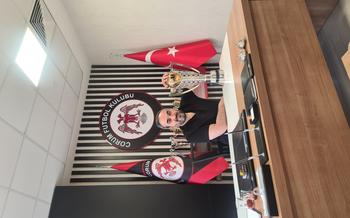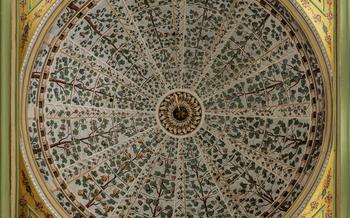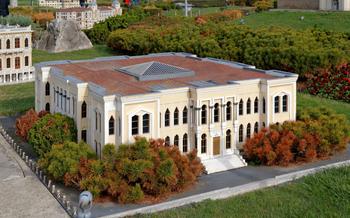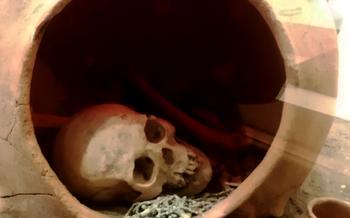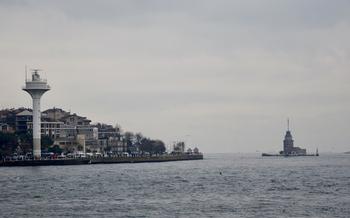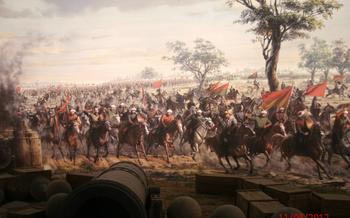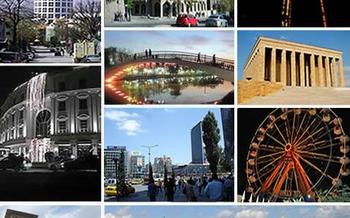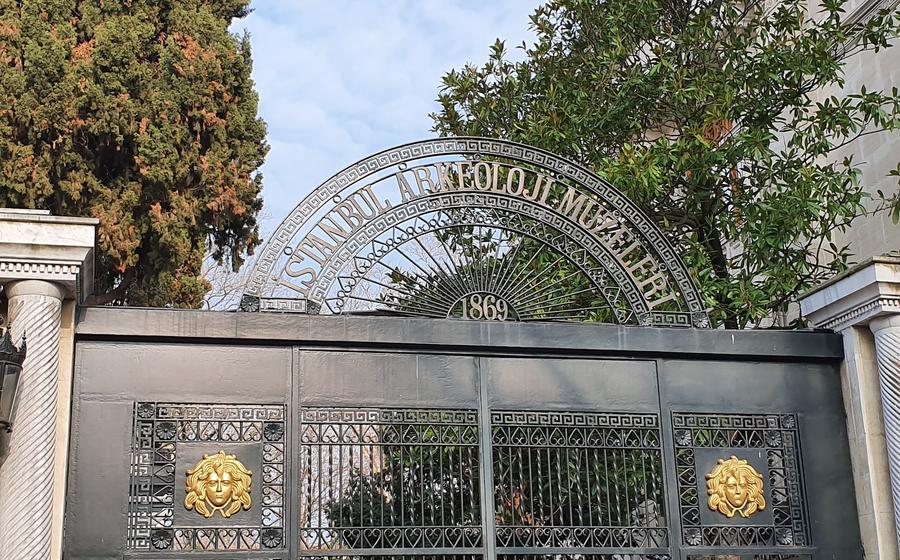
Istanbul Archaeology Museums
- A Journey Through Time: Exploring the Museum's Collections
- Unveiling the Secrets of the Past: The Museum's Highlights
- The Museum of the Ancient Orient: A Glimpse into Mesopotamia
- The Archaeological Museum: Treasures from Across Anatolia
- The Islamic Art Museum: A Showcase of Islamic Civilization
- The Tiled Kiosk Museum: A Unique Architectural Gem
- Insider Tips for Making the Most of Your Visit
- The Museum's Role in Preserving Turkey's Cultural Heritage
- The Museum's Contribution to Archaeological Research
- Controversies and Challenges Facing the Museum
- The Museum's Future Plans and Developments
- Personal Anecdotes and Reflections from Visitors
- Insider Tip: Uncovering Hidden Gems
A Journey Through Time: Exploring the Museum's Collections
The Istanbul Archaeology Museums house an astonishing array of artifacts and exhibits that take visitors on a journey through time, spanning from the prehistoric era to the Ottoman Empire. The Prehistoric Collection showcases fascinating stone tools, pottery, and figurines that provide a glimpse into the lives of early humans in the region. The Ancient Civilizations Collection features an impressive display of artifacts from ancient Mesopotamia, Egypt, Greece, and Rome, including cuneiform tablets, hieroglyphs, sculptures, and jewelry. The Islamic Art and Culture Collection boasts a stunning array of ceramics, textiles, metalwork, and calligraphy, showcasing the rich artistic traditions of the Islamic world. Finally, the Ethnographic Displays offer an intriguing insight into the diverse cultures and traditions of Turkey, with exhibits on traditional costumes, jewelry, and handicrafts.
Unveiling the Secrets of the Past: The Museum's Highlights
Among the countless treasures housed within the Istanbul Archaeology Museums, a few exceptional exhibits stand out, captivating the imagination and transporting visitors to distant lands and ancient civilizations. One such masterpiece is the Lion of Babylon, a colossal statue of a lion sculpted from black basalt, its fierce gaze commanding attention from across the room. This majestic creature once guarded the entrance to the ancient city of Babylon, symbolizing the power and strength of the Babylonian Empire.
Another highlight of the museum is the Alexander Sarcophagus, an elaborately carved marble coffin adorned with intricate reliefs depicting scenes from the life of Alexander the Great. Discovered in Sidon, Lebanon, this exquisitely crafted sarcophagus is a testament to the skill and artistry of ancient Greek craftsmen. Its intricate carvings offer a glimpse into the legendary life and conquests of Alexander, the renowned Macedonian king who left an indelible mark on history.
The Erechtheion Caryatid is another iconic artifact housed within the museum's walls. Originally part of the Erechtheion temple on the Acropolis in Athens, this graceful female figure, carved from Pentelic marble, embodies the architectural prowess of ancient Greece. Her serene expression and elegant posture have captivated visitors for centuries, making her one of the most recognizable symbols of classical antiquity.
Finally, the Mosaic Museum, located within the grounds of the Istanbul Archaeology Museums, showcases a stunning collection of Byzantine mosaics from various churches and palaces across Turkey. These intricate works of art, composed of millions of tiny colored tiles, depict religious scenes, historical events, and everyday life, offering a glimpse into the vibrant artistic traditions of the Byzantine Empire. The museum's collection includes some of the finest examples of Byzantine mosaic art, including the renowned "Great Palace Mosaic," which depicts a bustling imperial procession.
The Museum of the Ancient Orient: A Glimpse into Mesopotamia
Step into the Museum of the Ancient Orient, a treasure trove of artifacts that transport you back to the cradle of civilization. Immerse yourself in the grandeur of ancient Mesopotamia, where empires flourished and cultures collided. Discover the rich legacy of the Sumerians, Babylonians, and Assyrians through a diverse collection of cuneiform tablets, sculptures, reliefs, and everyday objects.
Cuneiform tablets, the earliest known form of writing, serve as a testament to the intellectual achievements of Mesopotamia. Decipher the stories, laws, and administrative records inscribed on these clay tablets, gaining insights into the lives and thoughts of ancient civilizations.
Marvel at the intricately carved sculptures and reliefs that adorn the museum's walls. Witness the grandeur of Assyrian reliefs depicting scenes of war and conquest, capturing the power and majesty of this ancient empire. Admire the delicate beauty of Sumerian statuettes, revealing the artistic prowess of this early civilization.
Delve into the daily lives of Mesopotamians through the collection of everyday objects. From pottery and jewelry to tools and weapons, these artifacts provide a glimpse into the social and domestic aspects of ancient Mesopotamian society.
The Museum of the Ancient Orient offers a unique opportunity to explore the roots of civilization. As you wander through its galleries, you'll gain a deeper appreciation for the rich cultural heritage of Mesopotamia, a region that laid the foundation for much of our modern world.
The Archaeological Museum: Treasures from Across Anatolia
The Archaeological Museum, one of the three main buildings of the Istanbul Archaeology Museums complex, houses a vast collection of artifacts from across Anatolia, spanning from the Neolithic period to the Byzantine era. This museum takes visitors on a journey through the rich cultural heritage of Turkey, showcasing the diverse civilizations that have flourished in this region over millennia.
Among the highlights of the collection are the Neolithic and Chalcolithic artifacts, which provide a glimpse into the earliest human settlements in Anatolia. These include finely crafted stone tools, pottery, and figurines that offer insights into the daily lives of our ancestors. The Bronze Age and Iron Age finds, on the other hand, showcase the technological advancements and artistic achievements of the region's ancient inhabitants.
The museum also boasts an impressive collection of Greek, Roman, and Byzantine artifacts, reflecting the influence of these civilizations on Anatolia. Visitors can admire exquisite marble sculptures, finely detailed mosaics, and intricate jewelry that demonstrate the artistic prowess of these ancient cultures. In addition, the museum houses a remarkable collection of artifacts from various Anatolian civilizations, such as the Hittites, Phrygians, and Lycians, providing a glimpse into their unique identities and contributions to the region's rich history.
The Islamic Art Museum: A Showcase of Islamic Civilization
The Islamic Art Museum, housed in the former İbrahim Pasha Palace, is a treasure trove of Islamic art and culture. Its collection spans from the 7th to the 19th centuries and includes over 40,000 artifacts from across the Islamic world. Visitors can admire exquisite examples of Islamic calligraphy, ceramics, textiles, metalwork, woodwork, and architectural elements.
The museum's collection of Islamic calligraphy is particularly noteworthy. It features rare and beautiful manuscripts, Qur'ans, and other religious texts, as well as examples of secular calligraphy. The ceramics collection includes stunning examples of pottery, tiles, and porcelain from various Islamic dynasties. The textile collection features intricate embroideries, woven fabrics, and printed textiles from around the Islamic world.
The metalwork and woodwork collections showcase the incredible craftsmanship of Islamic artisans. Visitors can admire intricate metalwork objects, such as lamps, candlesticks, and incense burners, as well as finely carved wooden furniture, doors, and panels. The architectural elements collection includes fragments of mosques, palaces, and other buildings, which provide a glimpse into the architectural heritage of the Islamic world.
A visit to the Islamic Art Museum is a must for anyone interested in Islamic art and culture. The museum's collection is vast and diverse, and it offers a unique opportunity to learn about the rich artistic traditions of the Islamic world.
The Tiled Kiosk Museum: A Unique Architectural Gem
Amidst the bustling streets of Istanbul's historic Sultanahmet district, nestled between the Blue Mosque and the Hagia Sophia, stands a hidden gem that transports visitors to a bygone era of Ottoman splendor. The Tiled Kiosk Museum, also known as the Çinili Köşk, is a 16th-century Ottoman palace that has been meticulously restored and transformed into a museum showcasing Ottoman architecture and decorative arts.
Its name, Çinili Köşk, aptly translates to "Tiled Pavilion" or "Tiled Kiosk," a nod to the exquisite tilework that adorns its exterior and interior walls. The tiles, produced in the renowned İznik kilns, depict intricate floral patterns, geometric designs, and scenes from Ottoman life, creating a mesmerizing visual feast that captivates the senses.
Originally built as a summer retreat for Sultan Mehmed II, the conqueror of Constantinople, the Tiled Kiosk served as a private chamber for the sultan and his guests. Its elegant design and luxurious appointments reflected the grandeur and opulence of the Ottoman court. After centuries of neglect and disuse, the Tiled Kiosk was painstakingly restored in the 1950s and opened to the public as a museum in 196
Inside the museum, visitors can wander through a series of beautifully preserved rooms, each adorned with intricate tilework, carved woodwork, and painted ceilings. The exhibits showcase a variety of Ottoman artifacts, including ceramics, textiles, metalwork, and glassware, offering a glimpse into the refined taste and craftsmanship of the era.
The highlight of the museum is the stunning panoramic view of Istanbul that can be enjoyed from its upper terrace. Gazing out over the domes and minarets of the city, visitors can imagine themselves transported back in time, to the days when the Ottoman Empire ruled over vast lands and its sultans reveled in the splendor of their palaces.
The Tiled Kiosk Museum is a true hidden gem, offering visitors a unique opportunity to experience the beauty and artistry of Ottoman architecture and decorative arts. Its exquisite tilework, serene ambiance, and panoramic views make it a must-visit destination for anyone interested in Istanbul's rich history and cultural heritage.
Insider Tips for Making the Most of Your Visit
To ensure a truly fulfilling experience at the Istanbul Archaeology Museums, consider these insider tips:
-
Avoid the crowds: If possible, visit the museum during the week, as it tends to be less crowded than on weekends. This will allow you to explore the exhibits at your own pace and avoid long lines.
-
Plan your visit: With so much to see, it's helpful to plan your visit in advance. Decide which collections or exhibits you're most interested in and prioritize those. The museum's website provides detailed information on each collection, making it easier to create a customized itinerary.
-
Take advantage of the free Wi-Fi: The museum offers free Wi-Fi to its visitors, so take advantage of this to enhance your experience. Use your smartphone or tablet to access online resources, such as the museum's website or audio guides, to learn more about the exhibits.
-
Visit the museum's café: After exploring the vast collections, take a break and relax at the museum's café. Located in the courtyard, the café offers a variety of refreshments, including traditional Turkish coffee, tea, and snacks. It's a great place to rest your feet and reflect on your visit.
The Museum's Role in Preserving Turkey's Cultural Heritage
The Istanbul Archaeology Museums play a crucial role in preserving and promoting Turkey's rich cultural heritage. The museum's extensive collection of artifacts and artworks from various civilizations and periods serves as a valuable resource for researchers, scholars, and the general public. The museum is committed to preserving and conserving these artifacts through ongoing conservation and restoration efforts. By doing so, the museum ensures that these treasures remain accessible and can be enjoyed by future generations.
In addition to conservation efforts, the museum actively engages in educational programs and outreach activities to promote cultural understanding and appreciation. Through exhibitions, lectures, and workshops, the museum educates visitors about the diverse cultures and civilizations that have shaped Turkey's history. The museum also collaborates with other institutions, both in Turkey and internationally, to share knowledge and expertise in the field of archaeology.
The Museum's Contribution to Archaeological Research
The Istanbul Archaeology Museums play a pivotal role in advancing the field of archaeology through their extensive research and scholarly endeavors. The museum's team of archaeologists and researchers conducts excavations and fieldwork throughout Turkey, unearthing valuable artifacts and shedding light on ancient civilizations. Their findings are documented, analyzed, and published in scholarly journals and books, contributing to the global body of knowledge about the region's rich past.
The museum also fosters collaboration with international scholars and institutions, facilitating the exchange of ideas and expertise. Joint research projects, conferences, and workshops bring together experts from diverse backgrounds to explore new perspectives and methodologies. By actively participating in the international archaeological community, the museum contributes to the advancement of the field on a global scale.
Through its research and collaboration, the Istanbul Archaeology Museums not only preserve Turkey's cultural heritage but also push the boundaries of archaeological knowledge. The museum's contributions have led to new discoveries, revised interpretations of history, and a deeper understanding of the ancient world.
Controversies and Challenges Facing the Museum
The Istanbul Archaeology Museums, like many other cultural institutions worldwide, have faced their share of controversies and challenges. One of the most prominent issues is the debate surrounding the restitution of artifacts to their countries of origin. Some critics have argued that certain objects, particularly those obtained during colonial periods, should be returned to their rightful owners. The museum has responded by emphasizing its commitment to preserving and protecting its collection for the benefit of all visitors, regardless of nationality.
Another challenge lies in the museum's funding and resource constraints. Like many public institutions, the Istanbul Archaeology Museums must balance its responsibilities to the public with limited financial resources. This can sometimes lead to difficulties in maintaining the museum's facilities, acquiring new exhibits, and providing adequate staffing.
Striking a balance between preservation and accessibility is another ongoing challenge. The museum's vast collection includes fragile artifacts that require careful handling and storage. However, the museum also recognizes the importance of making its treasures accessible to the public. This delicate balance requires careful planning and management to ensure that the collection is preserved for future generations while still being available for study and appreciation.
Finally, the museum must navigate the challenges of managing tourism and visitor impact. As one of Istanbul's most popular attractions, the museum receives a large number of visitors each year. This can lead to wear and tear on the exhibits and the museum's infrastructure. The museum has implemented various measures to mitigate these impacts, such as crowd control measures, guided tours, and audio guides.
The Museum's Future Plans and Developments
The Istanbul Archaeology Museums are constantly evolving to meet the needs of visitors and to showcase the latest discoveries in archaeology. In recent years, the museum has undergone extensive renovation and expansion projects, resulting in new exhibition spaces, improved visitor facilities, and a more accessible and engaging museum experience.
One of the most significant developments is the construction of a new wing dedicated to the Museum of Anatolian Civilizations. This new wing will house a vast collection of artifacts from Turkey's rich pre-Islamic past, including the famous Neolithic sculptures from Çatalhöyük and Bronze Age treasures from the Hittite Empire.
The museum is also investing in digital initiatives and online resources to make its collections more accessible to a global audience. Visitors can now explore virtual tours of the museum's galleries, view high-resolution images of artifacts, and access a wealth of information about Turkish archaeology and history.
Through these ongoing projects and initiatives, the Istanbul Archaeology Museums are positioning themselves as a leading center for archaeological research and cultural heritage preservation, while continuing to provide visitors with an unforgettable and enriching museum experience.
Personal Anecdotes and Reflections from Visitors
My first visit to the Istanbul Archaeology Museums was a revelation. I had no idea that such a treasure trove of history and culture existed in the heart of Istanbul. I spent hours wandering through the galleries, marveling at the exquisite artifacts and absorbing the stories they told.
One of my favorite exhibits was the Lion of Babylon, a colossal statue that once guarded the entrance to the ancient city of Babylon. The sheer size and majesty of the statue were awe-inspiring, and I couldn't help but imagine the history it had witnessed over the centuries.
Another highlight of my visit was the Erechtheion Caryatid, a marble statue of a woman that was originally part of the Erechtheion temple on the Acropolis in Athens. The statue was exquisitely carved, and I was fascinated by the way it seemed to come to life as I walked around it.
I also enjoyed visiting the Tiled Kiosk Museum, a beautiful 16th-century Ottoman palace that is now home to a collection of Islamic art. The intricate tilework on the walls and ceilings was simply stunning, and I spent a long time admiring the delicate patterns and colors.
Overall, my visit to the Istanbul Archaeology Museums was an unforgettable experience. I learned so much about the history and culture of Turkey and the wider region, and I was inspired by the beauty and craftsmanship of the artifacts on display. I highly recommend a visit to this amazing museum to anyone who is interested in history, culture, or art.
Insider Tip: Uncovering Hidden Gems
Beyond the well-known highlights, the Istanbul Archaeology Museums offer a wealth of hidden gems waiting to be discovered. In the Museum of the Ancient Orient, seek out the stunningly preserved gold jewelry from the Royal Cemetery of Ur, dating back to the 3rd millennium BC. In the Archaeological Museum, don't miss the exquisite ivory carvings from the Hittite city of Arslantepe, which provide a glimpse into the artistry of this ancient Anatolian civilization.
For a unique perspective of the museum complex, climb to the rooftop terrace of the Tiled Kiosk Museum. Here, you'll be rewarded with panoramic views of the city, including the iconic Hagia Sophia and the Bosphorus Strait. Take a moment to soak in the beauty of Istanbul's skyline and appreciate the museum's role in preserving the city's rich history.
If you're a fan of souvenirs, venture beyond the main gift shop to discover hidden treasures in the smaller shops scattered throughout the museum complex. You'll find a range of unique items, from handmade replicas of ancient artifacts to traditional Turkish handicrafts.
Finally, take the time to explore the museum's surroundings. Just outside the main entrance, you'll find the Gülhane Park, a sprawling green oasis in the heart of Istanbul. Take a leisurely stroll through the park, admire the beautiful flower gardens, and visit the Museum of Turkish and Islamic Arts, which houses a fascinating collection of Islamic artifacts from around the world.

